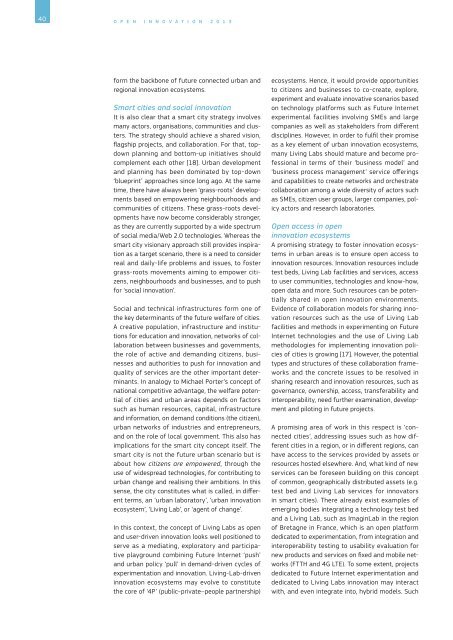Open Innovation 2.0 Yearbook 2013 - European Commission - Europa
Open Innovation 2.0 Yearbook 2013 - European Commission - Europa
Open Innovation 2.0 Yearbook 2013 - European Commission - Europa
Create successful ePaper yourself
Turn your PDF publications into a flip-book with our unique Google optimized e-Paper software.
40 O P E N I N N O V A T I O N 2 0 1 3<br />
form the backbone of future connected urban and<br />
regional innovation ecosystems.<br />
Smart cities and social innovation<br />
It is also clear that a smart city strategy involves<br />
many actors, organisations, communities and clusters.<br />
The strategy should achieve a shared vision,<br />
flagship projects, and collaboration. For that, topdown<br />
planning and bottom-up initiatives should<br />
complement each other [18]. Urban development<br />
and planning has been dominated by top-down<br />
‘blueprint’ approaches since long ago. At the same<br />
time, there have always been ‘grass-roots’ developments<br />
based on empowering neighbourhoods and<br />
communities of citizens. These grass-roots developments<br />
have now become considerably stronger,<br />
as they are currently supported by a wide spectrum<br />
of social media/Web <strong>2.0</strong> technologies. Whereas the<br />
smart city visionary approach still provides inspiration<br />
as a target scenario, there is a need to consider<br />
real and daily-life problems and issues, to foster<br />
grass-roots movements aiming to empower citizens,<br />
neighbourhoods and businesses, and to push<br />
for ‘social innovation’.<br />
Social and technical infrastructures form one of<br />
the key determinants of the future welfare of cities.<br />
A creative population, infrastructure and institutions<br />
for education and innovation, networks of collaboration<br />
between businesses and governments,<br />
the role of active and demanding citizens, businesses<br />
and authorities to push for innovation and<br />
quality of services are the other important determinants.<br />
In analogy to Michael Porter’s concept of<br />
national competitive advantage, the welfare potential<br />
of cities and urban areas depends on factors<br />
such as human resources, capital, infrastructure<br />
and information, on demand conditions (the citizen),<br />
urban networks of industries and entrepreneurs,<br />
and on the role of local government. This also has<br />
implications for the smart city concept itself. The<br />
smart city is not the future urban scenario but is<br />
about how citizens are empowered, through the<br />
use of widespread technologies, for contributing to<br />
urban change and realising their ambitions. In this<br />
sense, the city constitutes what is called, in different<br />
terms, an ‘urban laboratory’, ‘urban innovation<br />
ecosystem’, ‘Living Lab’, or ‘agent of change’.<br />
In this context, the concept of Living Labs as open<br />
and user-driven innovation looks well positioned to<br />
serve as a mediating, exploratory and participative<br />
playground combining Future Internet ‘push’<br />
and urban policy ‘pull’ in demand-driven cycles of<br />
experimentation and innovation. Living-Lab-driven<br />
innovation ecosystems may evolve to constitute<br />
the core of ‘4P’ (public–private–people partnership)<br />
ecosystems. Hence, it would provide opportunities<br />
to citizens and businesses to co-create, explore,<br />
experiment and evaluate innovative scenarios based<br />
on technology platforms such as Future Internet<br />
experimental facilities involving SMEs and large<br />
companies as well as stakeholders from different<br />
disciplines. However, in order to fulfil their promise<br />
as a key element of urban innovation ecosystems,<br />
many Living Labs should mature and become professional<br />
in terms of their ‘business model’ and<br />
‘business process management’ service offerings<br />
and capabilities to create networks and orchestrate<br />
collaboration among a wide diversity of actors such<br />
as SMEs, citizen user groups, larger companies, policy<br />
actors and research laboratories.<br />
<strong>Open</strong> access in open<br />
innovation ecosystems<br />
A promising strategy to foster innovation ecosystems<br />
in urban areas is to ensure open access to<br />
innovation resources. <strong>Innovation</strong> resources include<br />
test beds, Living Lab facilities and services, access<br />
to user communities, technologies and know-how,<br />
open data and more. Such resources can be potentially<br />
shared in open innovation environments.<br />
Evidence of collaboration models for sharing innovation<br />
resources such as the use of Living Lab<br />
facilities and methods in experimenting on Future<br />
Internet technologies and the use of Living Lab<br />
methodologies for implementing innovation policies<br />
of cities is growing [17]. However, the potential<br />
types and structures of these collaboration frameworks<br />
and the concrete issues to be resolved in<br />
sharing research and innovation resources, such as<br />
governance, ownership, access, transferability and<br />
interoperability, need further examination, development<br />
and piloting in future projects.<br />
A promising area of work in this respect is ‘connected<br />
cities’, addressing issues such as how different<br />
cities in a region, or in different regions, can<br />
have access to the services provided by assets or<br />
resources hosted elsewhere. And, what kind of new<br />
services can be foreseen building on this concept<br />
of common, geographically distributed assets (e.g.<br />
test bed and Living Lab services for innovators<br />
in smart cities). There already exist examples of<br />
emerging bodies integrating a technology test bed<br />
and a Living Lab, such as ImaginLab in the region<br />
of Bretagne in France, which is an open platform<br />
dedicated to experimentation, from integration and<br />
interoperability testing to usability evaluation for<br />
new products and services on fixed and mobile networks<br />
(FTTH and 4G LTE). To some extent, projects<br />
dedicated to Future Internet experimentation and<br />
dedicated to Living Labs innovation may interact<br />
with, and even integrate into, hybrid models. Such
















